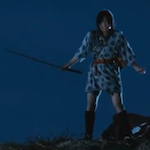
I knew right away that LEGEND OF THE EIGHT SAMURAI (1983) was gonna be interesting because the cosmic opening credits are backed by an English language rock song that would feel right at home in NO RETREAT NO SURRENDER. It’s called “White Light” and it was recorded specifically for the movie by John O’Banion, lead singer of Doc Severinsen’s band Today’s Children and winner on the pilot episode of Star Search.
The guitar solo starts over the director credit for Kinji Fukasaku (BATTLES WITHOUT HONOR AND HUMANITY), then abruptly fades out and we get this beautiful matte shot of an army, a castle and a red sky…
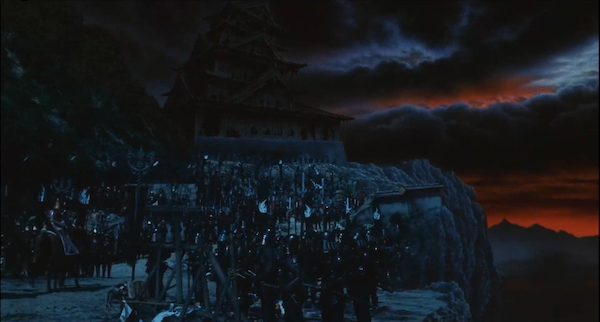
…with a big orchestra playing something more like you’d expect in a period samurai movie. The music is credited to six different people and veers between styles, mostly to my taste except when it resorts to keyboard horn sounds vaguely mimicking themes from STAR WARS, which seems pretty cheap. Mostly this is an extravagant affair, though, a lushly produced fantasy epic with colorful costumes, huge crowds of armored extras carrying spears and banners, atmospheric sets built on four giant soundstages, and a wicked queen to put the one from SNOW WHITE to shame.
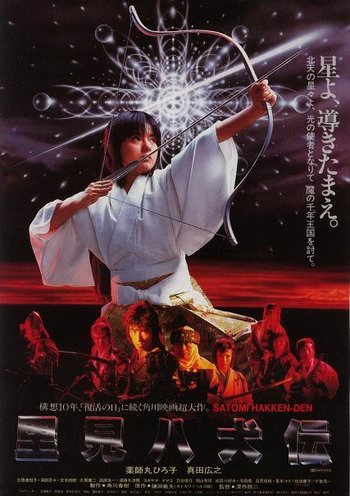 Tamazusa (Mari Natsuki, SPIRITED AWAY) and her family of evil ghosts seek supernatural power by slaying the entire Satomi Clan. Her son Motofuji (Yuki Meguro, OROCHI, THE EIGHT-HEADED DRAGON) brings her seven Satomi severed heads that they carry into a torch-lit underground chamber before they pour blood into a statue representing “The Eternal Spirit.” Whatever they’re trying to accomplish here, they can’t do it without the one that got away, Princess Shizu (Hiroko Yakushimaru, PRINCESS RACCOON). She’s out in the stormy wilderness with an old man named Ji who’s trying to deliver her to her uncle’s castle, while she can only think of revenge. But the rest of her party is killed or abducted and she’s on her own, with Ji’s sword.
Tamazusa (Mari Natsuki, SPIRITED AWAY) and her family of evil ghosts seek supernatural power by slaying the entire Satomi Clan. Her son Motofuji (Yuki Meguro, OROCHI, THE EIGHT-HEADED DRAGON) brings her seven Satomi severed heads that they carry into a torch-lit underground chamber before they pour blood into a statue representing “The Eternal Spirit.” Whatever they’re trying to accomplish here, they can’t do it without the one that got away, Princess Shizu (Hiroko Yakushimaru, PRINCESS RACCOON). She’s out in the stormy wilderness with an old man named Ji who’s trying to deliver her to her uncle’s castle, while she can only think of revenge. But the rest of her party is killed or abducted and she’s on her own, with Ji’s sword.
Then we meet a bunch of other characters. A guy named Shino (Masaki Kyômoto, CUTIE HONEY) is sad about his adopted sister Hamaji (Nana Okada) getting married. A shinobi named Keno (SISTER STREET FIGHTER herself, Etsuko Shihomi) is in the wedding disguised as a dancer, and assassinates a magistrate. As if that’s not enough drama, Hamaji makes a big scene declaring her love for Shino and is accidentally stabbed to death, causing Shino to rampage before finding a glowing crystal left behind when she died. These crystals will be important, obviously – there are eight of them engraved with Confucian virtues. It turns out the assassin Keno has the one for civility.
Shinbei (Hiroyuki motherfuckin Sanada – young, but nearly 20 years into his career) is the scoundrel of the story, a wandering wannabe warrior who enters to electric guitars and drum machines. He’s got armor and a horse stolen from the dead, and an antler tucked into a headband, I think to mimic the metal horns on most samurai helmets in this movie. He returns to his village lying about going to war, but nobody is excited about his return. An old man disgustedly tells him “While you were off trying to be a samurai or whatever” his adopted father died alone. Later he spots Shizu sneaking around and assumes she’s a thieving orphan (and also a boy, apparently she’s wearing a boy’s tunic). When he realizes she’s the princess he decides to try to claim the reward for himself.
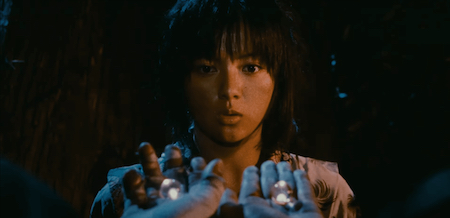 But another group with better intentions gets her first. Dōsetsu (Sonny motherfuckin Chiba) shows her a scroll explaining that Tamazusa was around a hundred years ago oppressing peasants and cursing their ancestors, but a whole thing happened with a joke that was taken too literally and caused a princess to marry a dog and then the princess was shot with eight bullets that exploded out of her as the magic crystals – long story. She said in 100 years the crystals would “become stewards who will serve a Satomi princess and overcome the curse.” Dōsetsu has her flute and two of the crystals that he and his friend were born holding, and they set out to find the other six crystals to become dog warriors and defeat the Queen. Oh yeah and he has a fatal disease and he’s on his last legs so if they don’t do it within a month they’re fucked. Good luck!
But another group with better intentions gets her first. Dōsetsu (Sonny motherfuckin Chiba) shows her a scroll explaining that Tamazusa was around a hundred years ago oppressing peasants and cursing their ancestors, but a whole thing happened with a joke that was taken too literally and caused a princess to marry a dog and then the princess was shot with eight bullets that exploded out of her as the magic crystals – long story. She said in 100 years the crystals would “become stewards who will serve a Satomi princess and overcome the curse.” Dōsetsu has her flute and two of the crystals that he and his friend were born holding, and they set out to find the other six crystals to become dog warriors and defeat the Queen. Oh yeah and he has a fatal disease and he’s on his last legs so if they don’t do it within a month they’re fucked. Good luck!
I can’t really keep track of all the villains, but I like how they each have their own weird shit going on. Tamazusa makes out with her son and bathes naked in a giant pool of blood. Motofuji was burned in a fire and collects the skin of noble women to magically replace his own. Genjin (Akira Shioji, 13 ASSASSINS) creates an army of beautiful women whose breath, blood and sweat is deadly poison. Yonosuke (Nagare Hagiwara, FALL GUY) is somehow connected to snakes, and a giant one (a well operated rubber puppet) often hovers over his shoulder. Funamushi (Mamako Yoneyama) is a haggard old witch who seems straight out of an anime.
Also Shinbei is kind of a bad guy at first, because he kidnaps the princess to claim a reward. So I will say that his thing is swinging around on a vine like Tarzan. After they come across the burned and slaughtered wreckage of a village that sheltered Shizu he starts to feel guilty and returns her to Dōsetsu, who chases him off (though Shizu supports him).
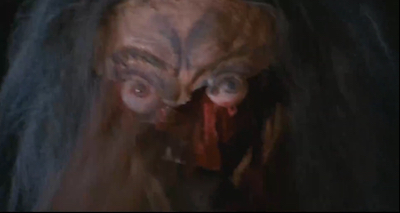 One of the highlights is when they stop at a place where there’s a blind, elderly mother who just got back from a walk in the woods. But she tries to eat Shizu’s eyes, saying it will make her see again. Then she tears her face off and there’s a giant centipede inside her. It turns out the poor old lady got possessed by this bug, now the dog warrior crew have to fight the fuckin thing. There’s an EVIL DEAD energy to the way the camera follows this huge centipede puppet thrashing around and smashing through walls. The special effects director was Nobuo Yajima, a veteran of tokusatsu shows including Giant Robot, Spectreman and Brain 17.
One of the highlights is when they stop at a place where there’s a blind, elderly mother who just got back from a walk in the woods. But she tries to eat Shizu’s eyes, saying it will make her see again. Then she tears her face off and there’s a giant centipede inside her. It turns out the poor old lady got possessed by this bug, now the dog warrior crew have to fight the fuckin thing. There’s an EVIL DEAD energy to the way the camera follows this huge centipede puppet thrashing around and smashing through walls. The special effects director was Nobuo Yajima, a veteran of tokusatsu shows including Giant Robot, Spectreman and Brain 17.
Unfortunately they gotta worry about more than just ghosts and goblins – also just society in general. Villagers try to catch her for the ransom, so she can only really trust the outcasts, like the tribe they meet inside a system of caves, left alone by the locals. “People are afraid of the way we look,” one explains. “They think our minds must be evil or bewitched.” The original goths and metalheads.
Once the crew has been gathered they face the Queen and family in a long climactic battle with tons of sword fighting, flipping around, the giant snake, lots of painted-on magic power FX (including a bow that shoots glowing arrows), bodies quickly decomposing and disintegrating, all kinds of good shit. Shinbei goes to town using the bow, but Princess Shizu has the honor of firing the kill shot through the Queen into the statue, which rolls the statue toward them RAIDERS OF THE LOST ARK style, followed by a fireball, and collapses the whole palace around them.
In an epilogue, Shinbei tends to stones piled up in honor of the dead samurai. They talk as the samurai and tell Shinbei and the princess to stay together. Pretty good endorsement – they better make that relationship work.
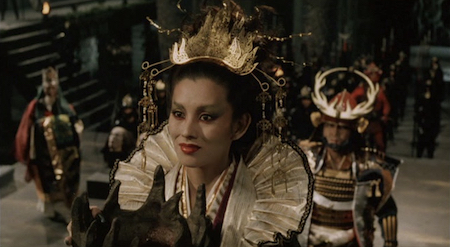 At the moment you can watch LEGEND OF THE EIGHT SAMURAI on a couple free streaming channels, but I discovered it from a recent limited edition blu-ray release in Eureka’s Masters of Cinema line. One of the extras on there is an interview with Fukasaku’s son Kenta (writer of the BATTLE ROYALE movies and director of the second one because his father died after shooting only one scene). Kinda like Tsui Hark’s ZU WARRIORS FROM THE MAGIC MOUNTAIN over in Hong Kong, the combination of visual effects and a mythical tale of a ragtag team battling a powerful evil seem like a response to the worldwide phenomenon of STAR WARS. In the interview Kenta confirms that the studio, Toei, asked Fukasaku to make a movie based on the relationship of Princess Leia and Luke Skywalker (though isn’t Shinbei more of a Han Solo?). I like that STAR WARS was so inspired by HIDDEN FORTRESS and now here’s a samurai movie inspired by STAR WARS.
At the moment you can watch LEGEND OF THE EIGHT SAMURAI on a couple free streaming channels, but I discovered it from a recent limited edition blu-ray release in Eureka’s Masters of Cinema line. One of the extras on there is an interview with Fukasaku’s son Kenta (writer of the BATTLE ROYALE movies and director of the second one because his father died after shooting only one scene). Kinda like Tsui Hark’s ZU WARRIORS FROM THE MAGIC MOUNTAIN over in Hong Kong, the combination of visual effects and a mythical tale of a ragtag team battling a powerful evil seem like a response to the worldwide phenomenon of STAR WARS. In the interview Kenta confirms that the studio, Toei, asked Fukasaku to make a movie based on the relationship of Princess Leia and Luke Skywalker (though isn’t Shinbei more of a Han Solo?). I like that STAR WARS was so inspired by HIDDEN FORTRESS and now here’s a samurai movie inspired by STAR WARS.
Of course, Fukasaku (with much of the same cast and crew) had already done MESSAGE FROM SPACE (1978), a movie more obviously indebted to STAR WARS. That was actually his first run at adapting Nansō Satomi Hakkenden, a gargantuan epic that author Kyokutei Bakinan serialized in 98 chapters published from 1814 to 1842. Sometimes just called Hakkenden, the story was retold in numerous kabuki performances, novels, manga, anime, TV shows and video games, with its first film adaptation released way back in 1913! MESSAGE FROM SPACE transported the story to the stars, but Fukasaku felt it still had popcorn movie potential in its original setting, so he wrote this version with Toshio Kamata, who simultaneously worked on a novelization released before the movie as Shin Satomi Hakkenden.

The way his son tells it, Fukasaku grew up worshiping the Emperor, so after WWII he felt like he’d been lied to his whole life, and always questioned authority from that point on. He saw himself as a peasant and he saw samurai as being high class, so he rewrote the famous story to have most of the heroes be outlaws and misfits. Those were his people, and they would be the ones to save the day, not some fuckin royalty.
(Well, except the main character is a princess, and they all got their powers from another princess. Slight oversight there. But I appreciate the sentiment.)
My favorite samurai movies have a pretty simple story structure that can set up an objective or a conflict that ties together the various events and tangents so that you can kind of wander around for a while and feel comfortable knowing there’s an X on the map for where you’re headed. I suppose that’s true here – they need to find the eight warriors to come together and kill the Queen – but because the whole backstory is so convoluted (and maybe difficult to translate), plus there are so many characters on both sides with their own gimmicks or storylines, it’s a little hectic and overwhelming to follow. But it’s a pretty fun story, it’s beautiful to look at, and I love the novelty of apparently trying to go a little Giorgio-Moroder-METROPOLIS with the soundtrack.
There’s actually a second John O’Banion song, a cheesy love ballad called “I Don’t Want This Night to End,” that plays during a long love scene and then replays on the end credits. I’ve read some very intelligent reviews from people much more knowledgeable than me that mention the songs being terrible and a blight on the movie, and I get where they’re coming from. That makes sense from a traditional, purist kind of stand point. But some of us are at a more sophisticated level of cinematic understanding where something that’s baffling and out of place and extremely dated can also Totally Rule and be one of the very best things about a movie. If I believed in star ratings I would add an extra one for the use of “White Light,” a strange concoction that could only come from the collision of these cultures at that specific pop culture moment in 1983, with the right mix of vision and not giving a fuck. It’s a big, weird world, and I love when we have proof.



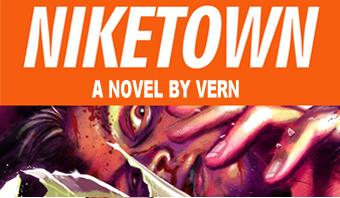






















April 1st, 2025 at 9:38 am
If becoming intelligent and knowledgeable means I have to start thinking that song is terrible, then I guess I’ll just have to stay stupid and ignorant.